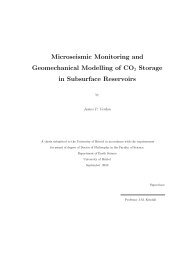MSAT - University of Bristol
MSAT - University of Bristol
MSAT - University of Bristol
You also want an ePaper? Increase the reach of your titles
YUMPU automatically turns print PDFs into web optimized ePapers that Google loves.
on the observed effective splitting. While the dip influences the results, the<br />
strongest effect comes from the interaction between the orientation <strong>of</strong> the two<br />
layers with respect to the polarisation.<br />
5 Summary<br />
We have described a Matlab toolkit designed to simplify the analysis and modelling<br />
<strong>of</strong> elastic and seismic anisotropy. This is fully documented and is freely<br />
reusable on a commercial and non-commercial basis. Notable components include<br />
the consistent implementation <strong>of</strong> a range <strong>of</strong> effective medium theories,<br />
tools to rotate, combine, decompose and summarise elasticity matrices, and<br />
functions to calculate parameters relating to seismic wave propagation such as<br />
shear wave splitting. In the examples above we have shown how this toolbox<br />
can be used to analyse single crystal elasticity, the seismic anisotropy <strong>of</strong> a<br />
polycrystalline aggregate, and backazimuthal variation <strong>of</strong> shear wave splitting<br />
generated by two dipping layers. Further example applications are distributed<br />
with the toolkit. Potential future enhancements which could be built into new<br />
versions <strong>of</strong> <strong>MSAT</strong> include the implementation <strong>of</strong> additional effective media<br />
theories (e.g. for layers <strong>of</strong> elastically anisotropic material) or <strong>of</strong> better approximations<br />
<strong>of</strong> the effect <strong>of</strong> multiple anisotropic regions along a seismic ray-path.<br />
6 Acknowledgments<br />
We are grateful to a large number <strong>of</strong> people who have shared code and insight<br />
on elastic and seismic anisotropy over the years, particularly David Mainprice<br />
and Mike Kendall. We also thank colleagues and collaborators who have tested<br />
21











